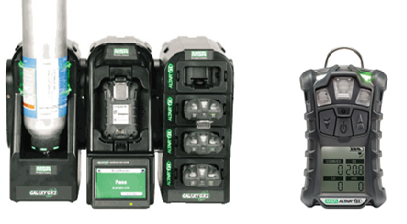Multi Gas Detector

The atmosphere in a crawl space may be hazardous for several reasons: the air may have too little or too much oxygen or the atmosphere may be toxic or explosive.
Most of the crawl spaces in Pembina Trails contain low-hazard atmospheres. However due to unforeseen hazards such as leaking pipes, hazardous equipment, standing water or hazardous work activities in these spaces the atmosphere may change during the work activity. As a result staff are required to carry a multi-gas detector with them when working in theses spaces. The monitor will alarm if there are any hazardous gases present beyond the preset limits in the detector.
Gas detectors can be requested/reserved for use through the divisional safety department and must be calibrated on a bi-weekly basis and be bump tested every day prior to first use.
How to Test the Atmosphere:
Atmospheric testing must be done as often as necessary before and while a worker is in a confined space to ensure that acceptable atmospheric levels are maintained. The atmospheric hazards of concern include oxygen content outside the acceptable range of 19.5 to 23%, the potential accumulation of flammable, combustible or explosive agents, or accumulation of atmospheric contaminants such as carbon monoxide and methane. Testing equipment includes the use of a multi-gas detector. Pembina Trails currently uses the MSA Altair multi-gas detectors for atmospheric testing of its confined spaces.
The multi-gas detector senses 4 types of gases: oxygen, carbon monoxide, flammable gases & explosives and hydrogen sulfide. The gas detector will alarm at the following setpoints:
Oxygen (O2):
- Low alarm: 19.5%;
- High alarm: 23%
Flammables and Explosives:
- Lower explosive level (LEL) : 10%
- Upper explosive level (UEL): 20%
Carbon Monoxide (CO):
- Low alarm: 25 ppm
- Short term exposure limit (STEL), max. exposure up to 15 min.: 100ppm
- Time weighted average (TWA), exposure over 8 hour period: 25ppm
Hydrogen Sulfide (H2S)
- Low alarm: 5.0ppm
- Short term exposure limit (STEL), max. exposure up to 15 min: 15ppm
- Time weighted average (TWA), exposure over 8 hour period: 1.0ppm
Where to Test the Atmosphere:
- Around the opening, before opening access to the space;
- At locations where transfer pipes lead to the space;
- Around irregular features such as baffles, bulkheads, and sumps;
- At locations where workers perform work;
- At all elevations inside the space, and in those areas where gases and vapours are likely to accumulate.
How to Use the MSA Altair 4X - Multi Gas Deterctor:
- Turn the gas detector ON by pressing the middle button. The instrument will warm up, go through sensor discovery and indicate low and high alarm settings, current date and last date of calibration.
- When the instrument flashes "FAS", fresh air setup, press the middle button to accept.
- The gas detector is ready to use.
- If the detector alarms, evacuate the area and call your supervisor or the safety officer.
- If the detector has alarmed, relocate to a safe area. Press the down arrow button to page through the screens to determine the reason for the alarm.
- The first screen is for bump testing.
- The second screen show peak exposure values.
- The next screen indicates minimum exposure values for O2.
- The next screen indicates STEL values for CO and H2S.
- The next screen indicates TWA values for CO and H2S.
- The next two screens indicate the time and date.
- The next screen asks if you would like to turn the motion
sensor on or off. The motion sensor, when turned on, will
alarm after a worker stops moving for 30 seconds. To
silence the alarm move the detector.
6. To turn off the machine press the button and hold for three
seconds.
*** For printable instructions click here***.


Please provide your question and email address in the fields below.
Your question has been successfully submitted.
CloseThank you.